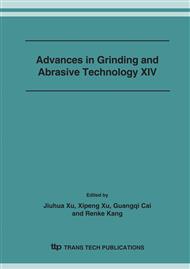p.219
p.224
p.229
p.234
p.239
p.244
p.249
p.254
p.259
Experiment Study on Residual Stresses Based on Quick-Point Grinding with Vitrified CBN Wheel
Abstract:
In this paper, we emphasize that residual stresses in a ground surface are primarily generated due to grinding zone temperature effect, and discuss grinding zone temperature can be debased based on characteristics of the thin vitrified bond CBN wheel and quick-point grinding. Via experimental results of 5 group working procedures, we find that surface roughness Ra showed a tendency to reduce slightly with infeed rate reduced, cut depth increased, grinding wheel speed and grinding variable angle increased, the favorable residual compressive stress could obtained along with variables angle(α, β) increased, the sub-surface white etching layer and tempered martensite layer in size become thinner with α, β angle and grinding wheel speed increased when removal rate Z=0.06mm3/mm keep constant in quick-point grinding, by contraries, surface quality were decreased entirely when variables angle(α, β) equal to zero. The results indicate it is important that grinding variable angle were choice in quick-point grinding for to obtain favorable residual compressive stress.
Info:
Periodical:
Pages:
239-243
Citation:
Online since:
November 2007
Authors:
Price:
Сopyright:
© 2008 Trans Tech Publications Ltd. All Rights Reserved
Share:
Citation:


